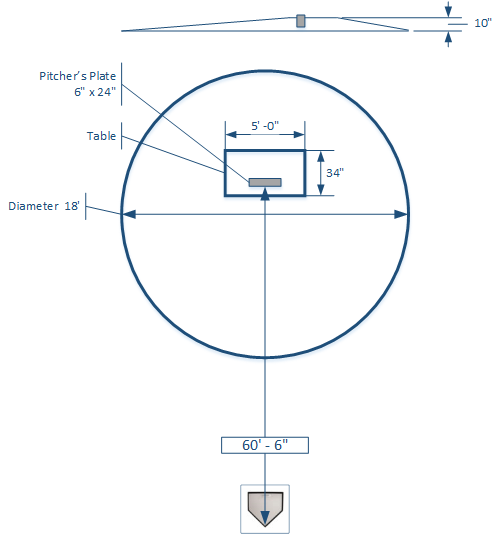 Pitcher's Mound and Dimensions
Pitcher's Mound and Dimensions
Umpiring various age levels and leagues, you are exposed to a variety of pitching dimensions. "Regulation" dimensions (those used in professional baseball, college, high school, and most amateur leagues whose players are about 14 and older) use a field composed of 90-foot base paths and a pitching distance of 60'-6" from the front of the pitcher's plate to the point at the rear of home plate.
Most youth leagues, however, use a variety of field dimensions and pitching distances, depending on the league and the age level of the players. Following is a summary of the most commonly used field dimensions.
Field dimensions in amateur baseball
Following are the most common pitching and field dimensions.
- Regulation field. As we've said, on a regulation field the pitching distance is 60'-6". The distance from base to base (the base path) is 90'. Regulation fields are used in professional baseball, of course, but also in college, high school, and most youth leagues whose players are about 14 and older.
- 54/80. Pony Baseball's Pony division (13-14 year olds) play on fields whose pitching distance is 54 feet and whose base paths measure 80 feet.
- 50/70. Little League introduced a new "Intermediate" division in 2012 for players from 11-13 that uses a 50-foot pitching distance and 70-foot base paths. Cal Ripken also has a 50/70 division for 11-12 year olds, and Pony Baseball uses these dimensions for its Bronco division (11-12 year olds).
- 46/60. A pitching distance 46 feet (with 60-foot base path) is standard for Little League divisions where the players are 12 and under. These dimensions are also common for other youth leagues whose players are 12 and under.
Note: Umpire field mechanics on playing fields measuring 50/70 and larger tend to be consistent, so throughout we will use the term "big diamond" to refer collectively to fields that are 50/70 and larger. Mechanics on 46/60 fields, however, are quite different, so we'll refer to 46/60 fields as "small diamond."
The pitcher's mound
On a regulation baseball diamond, the pitcher's mound measures 18' in diameter. The flat area atop the diamond, called the table, measures 5 feet wide by 34 inches deep. Six inches from the front edge of the table is the pitcher's plate (also called the rubber), which measures six inches deep by 24 inches wide.

The distance from the front edge of the pitcher's plate to the rear point of home plate measures 60'-6". This distance was established in 1893 and has served baseball well for 125 years. The height of the mound, however, has changed – most recently in 1969, when it was lowered to its present height of 10 inches. From the front of the table, the mound slopes down such that it loses one inch of height for every foot nearer to home plate.
These dimensions are the ideal, of course, and on professional fields an army of groundskeepers do well to maintain the proper dimensions. But a pitching mound is a difficult piece of ground to maintain, and on amateur fields you are most often lucky to see a mound that is wholly conforming to the regulations.